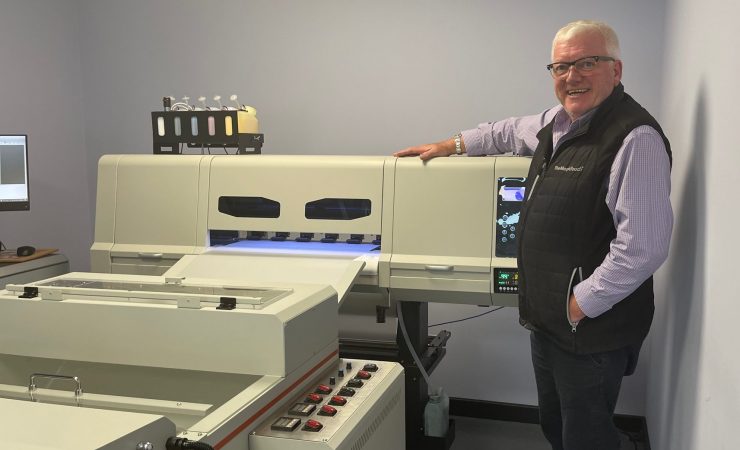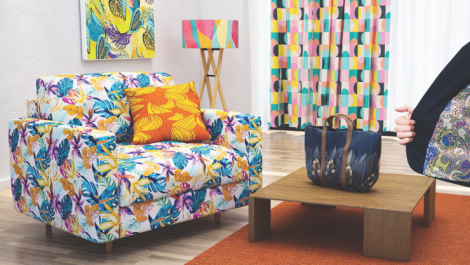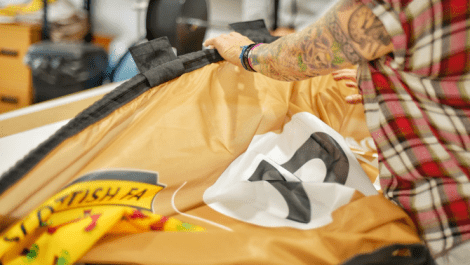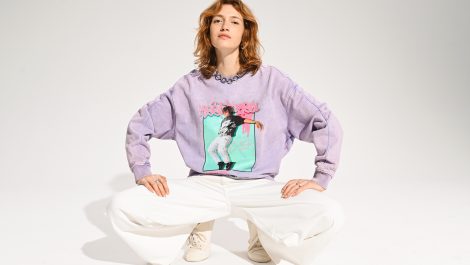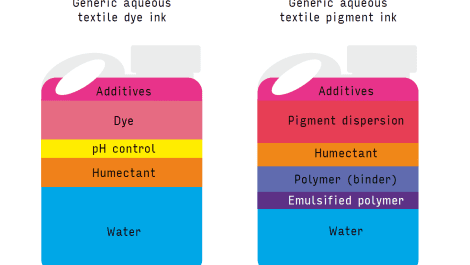In the world of digital print, especially when printing onto textiles, the acronym DTF invariably means direct-to-fabric. But Jim Nicol of The Magic Touch predicts that it might soon be direct-to-film that becomes ubiquitous across the industry…
The story began in October 2020 when The Magic Touch’s American operation reached out to Mr Nicol to introduce him to their latest idea. Thus it was over Zoom that the wheels were set in motion for an innovation that The Magic Touch says ‘bridges the gap’ between direct-to-garment (DTG), screen printing and traditional transfer printing methods.
What followed was a six-month process where the company conducted an ‘extensive evaluation’ of all things relating to direct-to-film technology. This assessment concluded that one of the key considerations for garment decorators is the ability to produce short and long-run full colour transfers for garments and textiles, regardless of colour or composition, and compatible with cotton, polyester, leather, softshell, performance fabrics, pique blends, canvas or denim.
Direct-to-film
‘We thought it is a very clever idea when we first had exposure to the potential,’ Mr Nicol tells Digital Textile Printer. ‘But it did remind us a little of the DTG situation 15 years ago where everyone was re-jigging old Epson printers to try and come up with a solution. We put our heads together and in January of this year we made contact with Colin Marsh, the CEO at Resolute who had also indicated an interest in the technology so we thought why not collaborate rather than compete? We have a global network of The Magic Touch operations around the world, all with the potential to endorse this technology.’
All well and good, but what is the technology that’s got Mr Nicol so excited? In simplest terms, direct-to-film involves printing onto a film and then directly transferring the print onto fabric. The Magic Touch’s solution means printing a roll-fed, 60cm coated PET film using a pigment based textile ink, then lightly coating the printed transfer with a hot-melt adhesive powder. The transfer is then cured before being applied to the media using a traditional heat press. There is no pre-treatment required.
All this is achieved using the new flagship direct-to-film printer, the R-Jet Pro DTF, which features the latest in dual print head technology and is powered using the latest version of Resolute RIP PRO software to ensure control and colour management. The printer also boasts an ink mixing function designed to ensure the ‘perfect circulation’ of white ink and therefore resulting in minimal maintenance or production issues. Its wet cap system means it can be switched off for up to a month without the need to flush out the white ink.
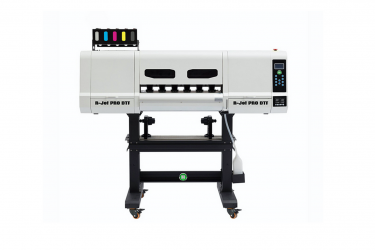
The R-Jet PRO DTF 600, the result of an ‘extensive evaluation’ of all things relating to direct-to-film technology.
The Magic Touch and Resolute claim that, for those looking for an affordable and reliable alternative to DTG, their new direct-to-film technology is ideal, also providing the look and feel of textile inks.
Mr Nicol is certainly confident in the end result. ‘You’ve got to see it to believe it,’ he says. ‘This process really is the best new production transfer solution for many, many years. With our transfer experience combined with Resolute’s knowledge and experience with DTG we believe we have the perfect combination to market and more importantly support this product beyond customer expectations. This really is a game changer for this industry.’
Head to head
But what is it that really sets the direct-to-film process apart from the alternatives, particularly DTG? One aspect is the low capital investment, as Mr Nicol explains, ‘There are DTG suppliers out there like Kornit, Aeoon and Epson all with some serious printers costing some serious money, but this direct-to-film configuration can be yours for £15,000. Higher-end options like the Kornit’s are great for those bigger companies that can afford it, but most people in my circles, if they had the £300,000 that they’d need, they’d be looking at retiring!
‘Then there are the restrictions that apply to some DTG options that just don’t to direct-to-film. One of the biggest is that people want to print onto polyester and that can be a nightmare using DTG… with our process they can do so in fantastic quality, with unmatched durability and stretchability, and regardless of colour or material. There’s no pre-treatment needed for the garment, a process that with DTG can take three, four, five minutes or even longer. By comparison we’ve just run a job involving 580 transfers, quite big ones at that, in only three and a half hours.
‘The system also has the scalability and you can easily work out exactly how long it will take to produce X number of transfers and at what cost.’
Mr Nicol says that his company never actually got involved with DTG printing, ‘simply because I wouldn’t have bought a DTG printer myself.’ He has no such qualms when it comes to direct-to-film however, indeed he expects the technology to quickly carve out quite a market share for itself. ‘There’ll be growth, no question,’ he says. ‘Particularly as it gets better and faster.
‘When we originally embarked on this project, our aim was to have something to showcase at Printwear & Promotion in February 2022, that’s always our biggest show of the year. As you can see we’re somewhat ahead of the game! Actually at the moment we can’t keep up with demand for the R-Jet Pros and we haven’t actually had a proper launch yet.
‘We know this technology is here to stay and our plan is to get to the end of this year with about 100 installed and up and running so that when we really push the button and tell the world about it we’ve got a track record of success we can call upon. DTG did it the other way round when it first came out, it tarnished the idea I’m afraid.’
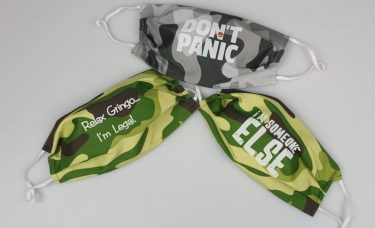
The direct-to-film solution can provide a range of textile products, including personalised facemasks
Those customers can come in almost any shape and size, as Mr Nicol explains. ‘The target audience is anyone. The bottom line is when you make something easy for people they’re more likely to do it. Over the past thirty years we’ve built up a business using sublimation technology, toner technology, transfer technology, vinyls, print and cut… all sorts really and this is, in a certain sense, just another option that might suit someone.
‘This isn’t a machine that is going in someone’s garage or their shed though, it’s not for the craft market. Maybe in the coming years the tech will scale itself down and, if it does, that will transform the entire decoration market. That applies to garments but also to other areas as these transfers can go on all sorts of things.’
Personalisation
For Mr Nicol the key thing is that the solution’s capabilities dovetail perfectly with wider trends that he thinks are essential for the industry. ‘People are only just grasping the power that personalisation has,’ he explains, ‘particularly when it comes to marketing. We’ve been banging the drum for years, but its only with things like the recent valuation of Moonpig (the company was floated earlier this year, with early share prices valuing the business at £1.4billion) that have made people sit up and take notice.
‘But it’s quite a trick to give someone a product with their name, logo and website information on it. It costs less than it would to buy them a cappuccino, but it can really blow them away. Printing technology has come on leaps and bounds over the last twenty or thirty years, but people’s attitudes when it comes to selling haven’t kept up.
‘I used to go to Ipex and I’m familiar with all the other big shows and my message has always been using all our products and techniques is a fantastic way of keeping in touch with customers, which is an area where the print industry lets itself down. When printers actually do remember to market themselves, its always based around price. That’s what has led to this race to bottom with larger trade printers that weren’t around years ago.
‘If companies aren’t employing sales people or marketing wisely, then they have to target properly. We’ve proved this ourselves… Sitting behind emails is pointless. All I’m really talking about is creating that engagement. I tell people that direct-to-film makes it dead easy, there’s no artwork or set up costs, the minimum order is one and the first one is free! If that doesn’t stick in their mind then nothing will! In short, don’t get hung up on the technology or how many you can make an hour, ask yourself how are you going to market it!’
Certainly it seems as though this technology is something to keep an eye on, it will be fascinating to see how things play out.

